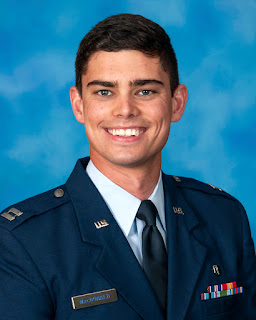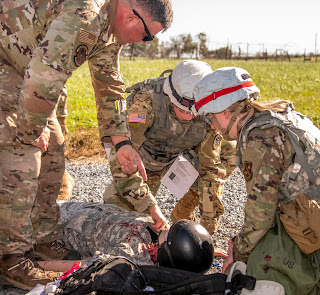USU Graduate Applies Medical School Lessons to Real-Life Mass Casualty Scene
By Sharon Holland
Air Force Capt. (Dr.) Austin MacDonald was headed to the Texas coast for a two-day beach getaway with friends. MacDonald, who had just come off some tough shifts at Brooke Army Medical Center where he is a first-year emergency medicine resident, had just fallen asleep in the backseat of his car next to their eight-month-old daughter while his wife, Natalie, drove. The couple was looking forward to introducing their baby to the beach, and Austin, a recent Uniformed Services University (USU) medical school graduate, was hoping to have some time to just turn off his brain and rest. In fact, he was so eager to hit the beach that he was already dressed in his swim trunks and flip flops.
In the middle of nowhere, they came upon an accident scene. Traffic had slowed, and Natalie woke Austin up.
“My wife woke me up and told me there weren’t any police or EMS there. My first thought was, ‘where are the lights and sirens’ and then ‘let me out – I need to help,’” MacDonald says. “We were, maybe, 20 yards out, so I got out and jogged (in my flip flops).”
About eight other people had stopped to help, and more were pulling over when the MacDonalds’ stopped. They could see a car on its side, and all of its seven passengers had been scattered around the median and highway, except for one who remained inside the vehicle. MacDonald says that he later learned the vehicle was traveling at about 75 miles per hour when a rear tire exploded, causing the driver to lose control. The car rolled multiple times, shattering the windows. None of the children had been wearing seatbelts and were all ejected. Three children were on the opposite side of the highway on the median and one lay in the middle lane.
“Everyone was scattered. Some were yelling in pain, others were laying still. The scene was complete chaos,” MacDonald recalls. “The closest thing I’ve witnessed was a simulation at Bushmaster. Bystanders were gathering around desperate to help, but shocked, many in tears.” Bushmaster is an annual medical field practicum where USU fourth-year medical students and advanced practice nursing students put into practice everything they have learned about triage, emergency, tactical and combat casualty care while at the university. The exercise scenarios are intense, stressful, and challenging situations that take place in an austere, field environment.
MacDonald says that bystanders were gathering around desperate to help, but shocked, with many in tears. He quickly assumed charge of triaging the rest of the scene.
Among the passengers were children and adults. One was a little boy, around whom most of the bystanders had been standing. A family physician had arrived on scene before MacDonald and was conducting CPR before realizing the child had an open head wound with visible brain matter. A lady in the crowd was begging him to keep going, but MacDonald did a pulse check after the other doctor completed a round of CPR, and they both concluded there was nothing that could be done to save the child. By this time the first ambulance arrived on scene, and crews began their own assessment of the child.
“I moved on to the other passengers, thinking ‘ABC, ABC’ [airway, breathing, circulation]. Everyone was breathing except for one kid, who I went to and took over CPR on him,” MacDonald recounts. The boy was in his early teens with intense bruising on his chest. A nurse appeared and helped continue CPR. Shortly after, a patrol officer arrived with an AED, and the nurse grabbed the pads and MacDonald asked the officer to continue CPR. The teen started to clench his mouth and his body went rigid. He wasn’t breathing well or responding. His Glasgow Coma Score was close to 3 or 4. The officer also had a first aid kit with airway equipment, so MacDonald put airways into each of the child’s nostrils, used a bag valve mask and continued CPR, and eventually was able to get a pulse back.
There was a second teenager among the injured. MacDonald determined that the child had a good pulse and airway, but believed there were acute abdominal injuries and a broken leg, so he recommended immediate medical evacuation.
The next passenger he saw was an elementary school-aged girl who was vomiting and semi-conscious. MacDonald laid her on her side, and had a bystander stay with her, while he moved on to another of the accident victims. One of the adults from the vehicle was down on hands and knees, throwing up, but breathing and talking. Unfortunately, MacDonald found that the second adult, who was still in the vehicle, was already deceased, and was trapped in the car with no way for him to extricate her.
“We were all relieved when EMS got there. I filled in EMS on the status of each patient and started to help with the triage order for evacuation. The EMS coordinator got on scene after we got [the pulse back] on the [teenaged] kid [who underwent CPR] and came over to me saying, ‘hey doc, great job, but if he codes again, we don’t have the resources.’ It was hard to hear, but he was right. There were only two ambulances there by then, with three EMS providers, myself, the nurse, and the family med doc. The EMS coordinator secured three helicopters, and we decided to send three kids (one with an acute abdomen and broken femur, one with a blunt chest injury who had received CPR, and a little girl who wasn’t sustaining her breathing), while the other was stable enough to go on an ambulance.”
Several weeks later, the EMS coordinator provided him with a few updates on the accident victims.
“Everyone who left the scene had stable vitals except for the teen who received CPR. They all made it to the hospitals they were bound for. Three out of four kids were doing well a few days out, but the boy who received CPR was taken off life support about two weeks later,” he shares.
MacDonald says that while it was a very tragic scene, he was grateful to have arrived when he did and to have had the experience and opportunity to help. He credits his Bushmaster training in his last year of medical school for his ability to help manage the scene.
“Bushmaster, and the entire military medicine curriculum were invaluable. Even simple things like properly placing an NPA [nasopharyngeal airway] are vital in an environment like this when resources are so limited,” MacDonald says. “I did a lot of talking and listening to the wounded. I think one of the pieces of Bushmaster that can get overlooked by students is the psychological first aid. It matters so much, too. In the moment, more than any formula or special acronym, it was just about being there, talking to each person, being there for them, letting them know they weren’t alone. I am proud to be training as an emergency medicine physician.”







